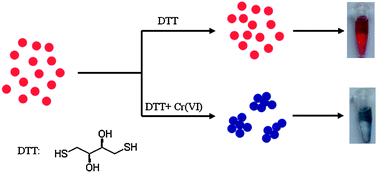The determination of trace Cr(VI) is very important because of its highly carcinogenic and mutagenic effects. In this study, a colorimetric detection method based on 1,4-dithiothreitol functionalized gold nanoparticles (DTT-AuNPs) for nanomolar Cr(VI) in aqueous solution is reported. The method principle was based on the aggregation of DTT-AuNPs induced by Cr(VI), which led to red-shift of the surface plasmon resonance (SPR) peak of DTT-AuNPs. UV-vis absorption spectra, Zeta potentials, and transmission electron microscopy (TEM) images were used to demonstrate the aggregation of DTT-AuNPs. Some parameters affecting the detection including solution pH and DTT concentration were optimized. Under the optimized conditions, a good linear relationship (correlation coefficient r = 0.997 5) was obtained between the ratio (A650/520) of the absorbance at 650 nm to that at 520 nm and the concentration of Cr(VI) over the range of 100–600 nM, and the limit of detection (LOD) for Cr(VI) at a signal-to-noise ratio of 3 was 20 nM. The method showed selective detection toward Cr(VI) against other common metal ions in waters. Furthermore, the method developed was applied for detecting trace Cr(VI) in real water samples, with recoveries of 95%–115%.

You have access to this article
 Please wait while we load your content...
Something went wrong. Try again?
Please wait while we load your content...
Something went wrong. Try again?


 Please wait while we load your content...
Please wait while we load your content...